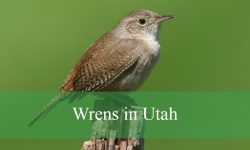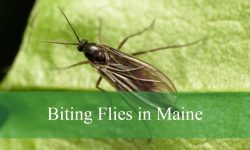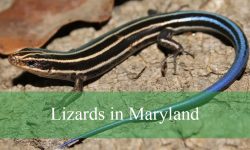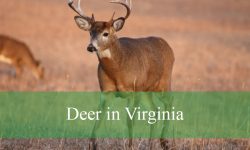Small birds in Delaware add vibrant life and charm to the state’s diverse habitats. From woodlands to wetlands, these birds showcase a wide range of colors, songs, and behaviors that delight birdwatchers and nature lovers alike. Understanding these small birds helps deepen appreciation for Delaware’s rich wildlife.
This guide highlights 40 small birds in Delaware, featuring clear pictures and detailed identification tips. Birdwatchers at all levels will find helpful information on how to recognize each species by size, color, song, and habitat. These small birds are an essential part of Delaware’s ecosystems.
By exploring this collection of small birds in Delaware, readers will learn where to find them throughout the year and what makes each species unique. From the busy Carolina Chickadee to the striking Northern Cardinal, these birds brighten Delaware’s skies and forests. Let’s dive into the fascinating world of Delaware’s small birds.
Common Small Birds Found in Delaware
Carolina Wren
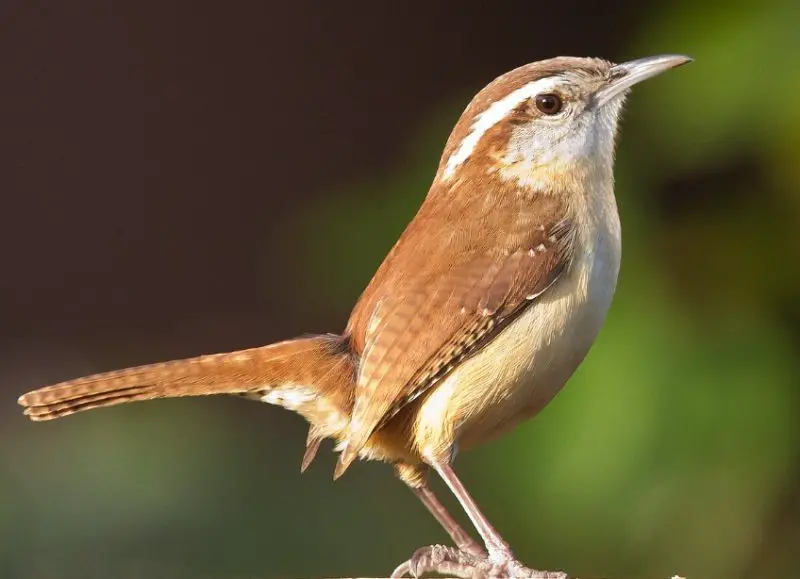
The Carolina Wren is a small, energetic songbird with a bold voice far bigger than its size. It is easily recognized by its warm reddish-brown upperparts, creamy underparts, and distinctive white eyebrow stripe. This wren has a slightly curved bill and a cocked tail, often held upright when perched.
At about 5.5 inches long and with a wingspan of 7–9 inches, the Carolina Wren is small but surprisingly loud. Its song consists of rapid, repetitive phrases like “tea-kettle, tea-kettle, tea-kettle,” which can be heard throughout the year. Both males and females sing, and their curious and active behavior often brings them into close view.
In Delaware, Carolina Wrens are common residents in wooded suburbs, brushy areas, and overgrown backyards. They prefer places with dense vegetation and sheltered spaces for nesting. Even in winter, they remain active and vocal, sometimes taking shelter in man-made structures like sheds or mailboxes.
Northern Cardinal
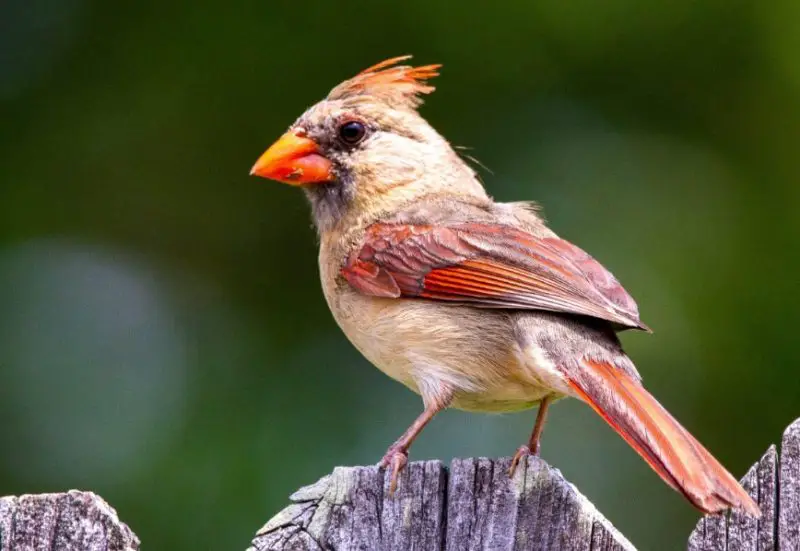
The Northern Cardinal is one of the most recognizable birds in Delaware, known for its vibrant coloration and melodic song. Males are bright red all over with a black mask around the face, while females are mostly tan or buff-colored with warm reddish tinges on the wings, tail, and crest. Both sexes have a distinctive crest and a thick, orange-red bill that makes them easy to identify year-round.
Measuring around 8–9 inches in length with a wingspan of about 10–12 inches, Northern Cardinals are medium-sized songbirds. Their song is a clear, whistling series of phrases often repeated several times, and they are known to sing throughout the day, even in winter. These birds do not migrate, making them permanent and welcome residents in gardens and woodlands.
In Delaware, Northern Cardinals are found in a variety of habitats including suburban yards, thickets, forest edges, and parks. They thrive in areas with dense shrubbery where they can forage for seeds, fruit, and insects. Their year-round presence and striking appearance make them a favorite among local birdwatchers.
Carolina Chickadee
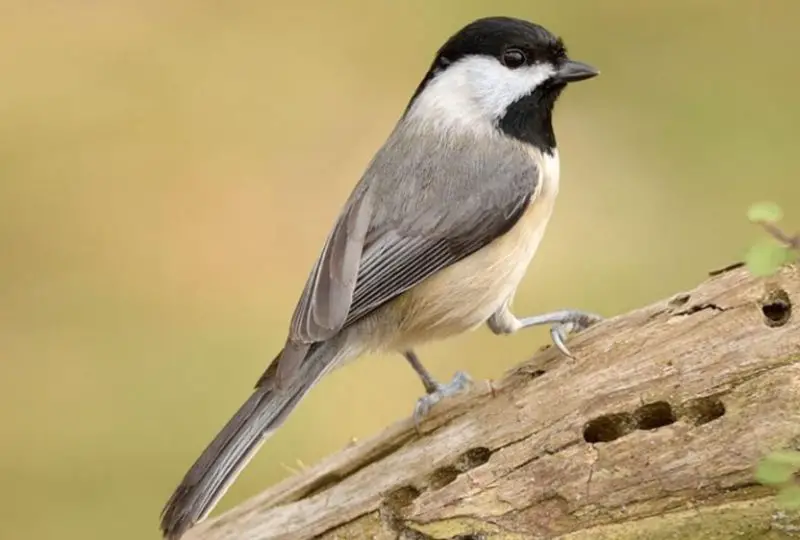
The Carolina Chickadee is a tiny, charming bird with a black cap and bib, white cheeks, and soft gray wings and back. Its underparts are pale gray to white, and it has a short neck and rounded body, giving it a very compact appearance. This species is nearly identical to the Black-capped Chickadee but is distinguished in Delaware by range and song.
Measuring around 4.5–5 inches in length with a wingspan of 6–8 inches, the Carolina Chickadee has a high-pitched, whistled call and rapid “chick-a-dee-dee-dee” vocalizations. They are very agile, often hanging upside down on branches and feeders as they search for insects, seeds, or suet.
Carolina Chickadees are year-round residents in Delaware, commonly found in deciduous forests, wooded parks, and suburban neighborhoods with mature trees. They readily visit backyard feeders and nest in cavities, including nest boxes. Their friendly behavior and familiar calls make them a delight for birdwatchers across the state.
American Goldfinch
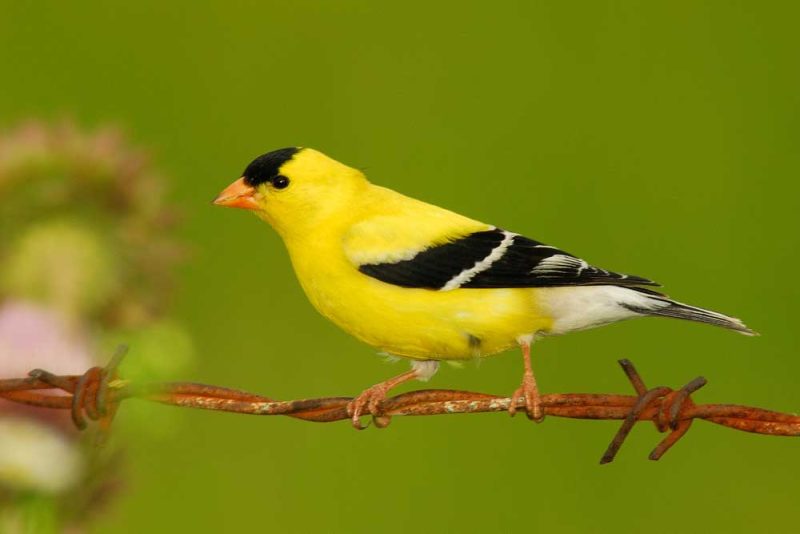
The American Goldfinch is a small, striking bird known for its bright yellow plumage and bounding flight. Males in summer are vivid yellow with black wings, a black forehead, and white tail markings, while females are more subdued with olive-yellow tones. In winter, both sexes adopt a more muted brownish coloring but retain their characteristic wing pattern.
Typically 4.5–5 inches long with a wingspan of about 7.5–8.5 inches, goldfinches are acrobatic and social, often feeding in flocks. Their song is a sweet, canary-like series of twitters and warbles, and their flight call is a distinctive “per-chik-o-ree” or “po-ta-to-chip” sound, especially noticeable in flight.
In Delaware, American Goldfinches are common in open fields, weedy meadows, and suburban areas with feeders. They are especially drawn to thistle and sunflower seeds. Though they may move around in winter, many remain in the state year-round, especially where food is plentiful. Their breeding peaks in late summer, timed with the seeding of native plants.
Tufted Titmouse
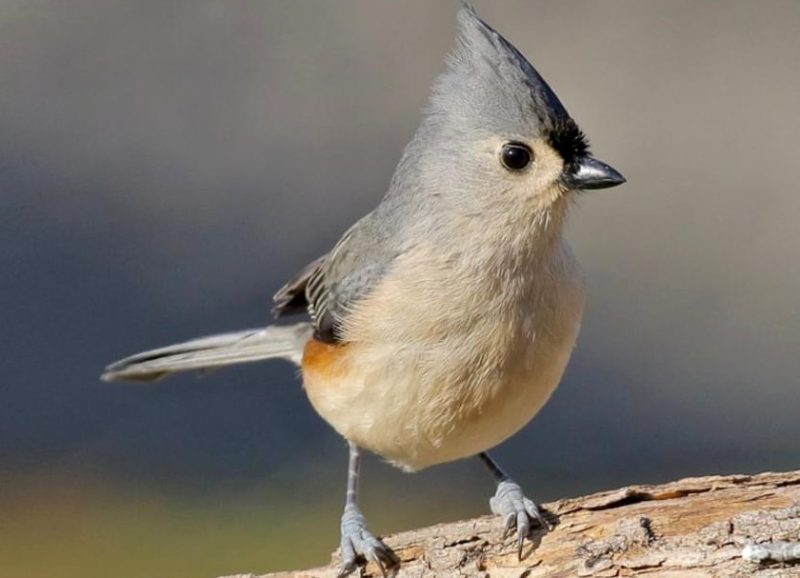
The Tufted Titmouse is a plump, gray songbird with a prominent crest, large black eyes, and a hint of rust under the wings. Its face is white, with a short, stout black bill. It is closely related to chickadees and often found in mixed feeding flocks during cooler months.
Measuring about 6–6.5 inches in length with a wingspan around 8–10 inches, the Tufted Titmouse is slightly larger than a chickadee. Its call is a whistled “peter-peter-peter” and a range of other chirps and scolding notes. These birds are active and curious, often seen darting between branches or visiting feeders with sunflower seeds and suet.
In Delaware, Tufted Titmice are widespread residents in deciduous forests, woodlots, and suburban yards. They are cavity nesters and often use nest boxes. Their consistent presence and vocal nature make them easy to spot throughout the year, especially in leafy areas and neighborhoods with mature trees.
Downy Woodpecker
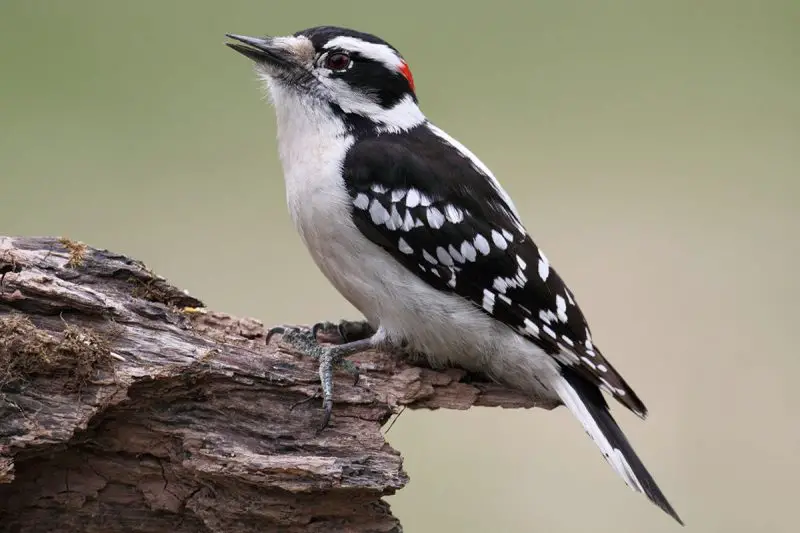
The Downy Woodpecker is the smallest woodpecker species in North America and is easily identified by its compact body, black-and-white plumage, and short bill. Males have a small red patch on the back of the head, while females lack this marking. Both sexes display a white back, black wings with white spots, and a black-and-white striped head.
Measuring about 5.5–6.7 inches long with a wingspan of 9–12 inches, the Downy Woodpecker is agile and active, often seen tapping along tree trunks and branches in search of insects. Their soft “pik” calls and rhythmic drumming are commonly heard in wooded areas. They also visit feeders, especially for suet, peanuts, and sunflower seeds.
In Delaware, Downy Woodpeckers are common year-round residents found in forests, woodlots, parks, and suburban yards. They are well adapted to both natural and human-altered habitats, making them familiar sights across the state. They often nest in small tree cavities or dead branches in wooded areas.
House Finch
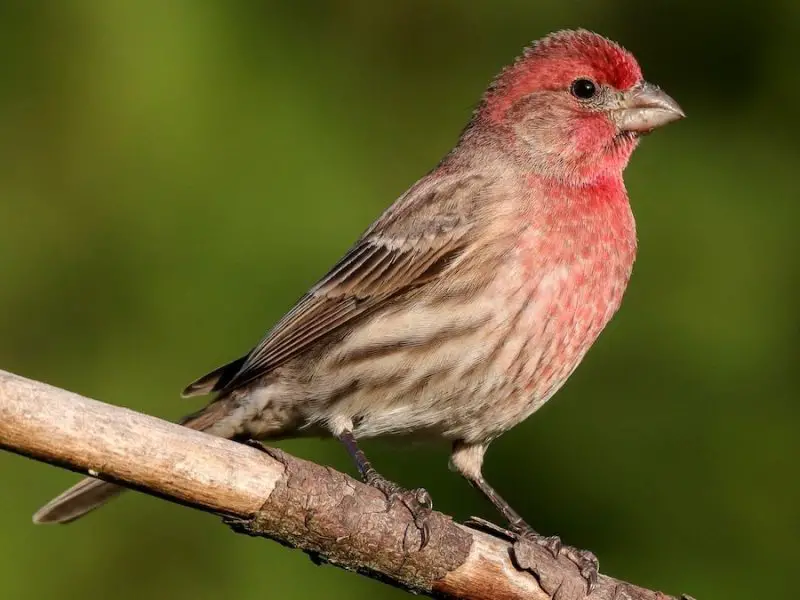
The House Finch is a small, sociable bird with a cheerful song and varied coloration. Males are typically rosy red on the head, throat, and chest, while females are brown and streaked all over. Both sexes have a short, conical bill and a long, notched tail that helps distinguish them from other finch species.
Measuring around 5–6 inches in length with a wingspan of 8–10 inches, House Finches are known for their sweet, warbling songs and constant chattering. They are frequent visitors to bird feeders, especially those stocked with black oil sunflower seeds. Their flight is undulating, and they often travel in noisy flocks.
In Delaware, House Finches are widespread and commonly found in urban, suburban, and rural areas. Originally native to the western U.S., they have successfully expanded eastward and are now permanent residents in the state. They build nests in a variety of sheltered places, including hanging planters, ledges, and light fixtures.
Song Sparrow
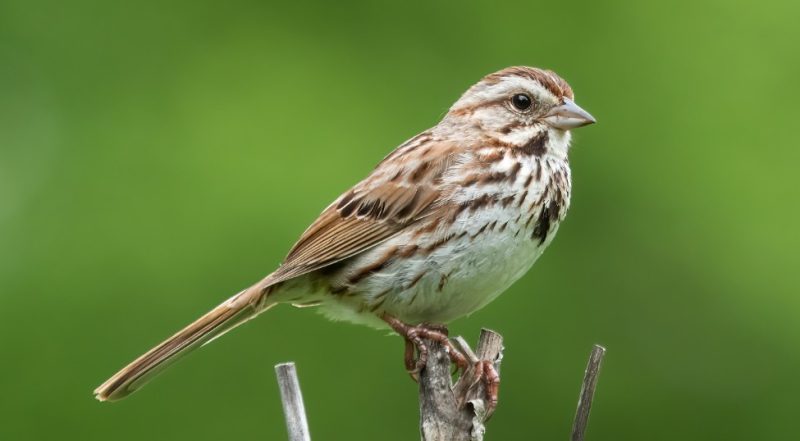
The Song Sparrow is a medium-sized sparrow with heavily streaked brown and gray plumage and a central dark spot on the chest. Its coloration and markings can vary regionally, but its rounded head, long tail, and strong facial stripes help with identification. The overall impression is of a well-camouflaged, earthy-toned bird.
Song Sparrows are about 5–7 inches in length with a wingspan of 7–9 inches. They are named for their rich, melodic song, which consists of a few clear notes followed by a series of trills and buzzes. Males often sing from low perches, especially during the breeding season. They forage mostly on the ground, feeding on seeds, insects, and small fruits.
In Delaware, Song Sparrows are found in a variety of habitats, including marshes, meadows, gardens, and woodland edges. They are year-round residents in the state and commonly seen at feeders and near brush piles. Their adaptability to different environments makes them one of the most widespread sparrow species in the region.
White-breasted Nuthatch
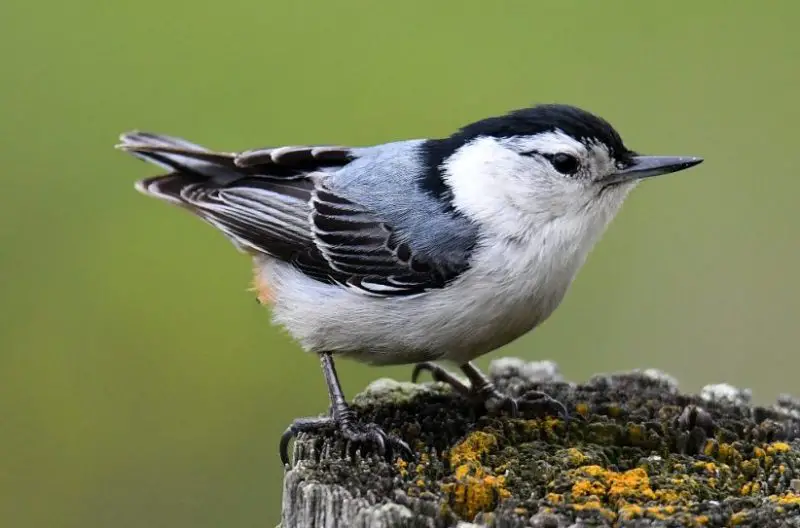
The White-breasted Nuthatch is a small bird with a clean white face and underparts, a bluish-gray back, and a black or dark crown. It has a short tail, long pointed bill, and strong legs that allow it to climb down trees headfirst—a behavior unique to nuthatches.
Measuring about 5–6 inches long with a wingspan of 8–11 inches, this bird is active and agile. It gives a nasal, yank-yank call and is often seen flitting among tree trunks and branches in search of insects and seeds. They store food in bark crevices for later use, especially in colder months.
In Delaware, White-breasted Nuthatches are non-migratory and commonly found in mature deciduous and mixed forests, as well as wooded suburban neighborhoods. They often join mixed-species flocks in winter and are regular visitors to bird feeders stocked with sunflower seeds, peanuts, or suet.
House Sparrow
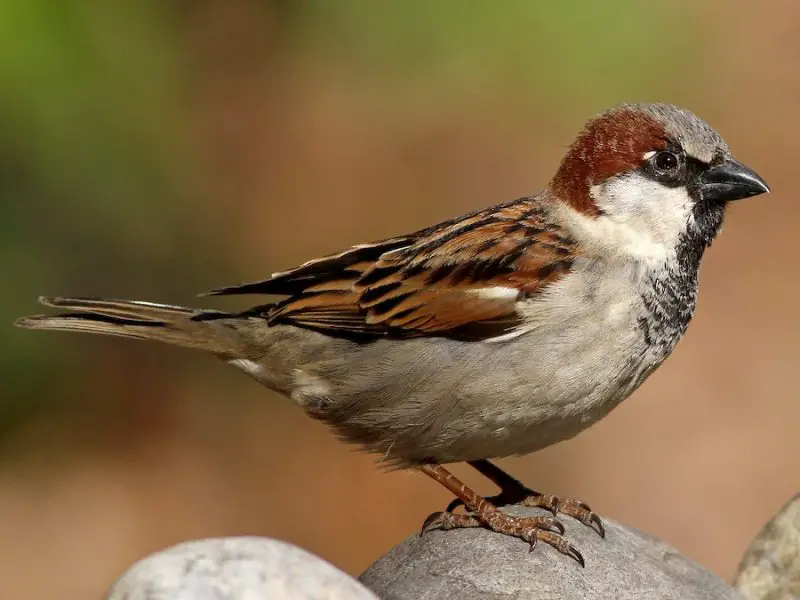
The House Sparrow is a small, stocky bird with a round head, thick bill, and short tail. Males have gray crowns, black bibs, and chestnut-colored napes, while females and young are more uniformly brown with streaked backs and lighter underparts. They are not true sparrows but belong to a different family from native North American species.
House Sparrows measure about 6 inches long with a wingspan of 7.5–9.8 inches. They are noisy and social, often found in bustling groups near buildings, sidewalks, and parking lots. Their chirping calls are constant in urban areas, and they often feed on crumbs, seeds, and scraps of human food.
In Delaware, House Sparrows are widespread in cities, towns, and farms. They nest in cavities, including vents, roofs, and street signs. Introduced from Europe in the 19th century, they have adapted well to human environments and are now one of the most abundant urban birds in the state.
European Starling
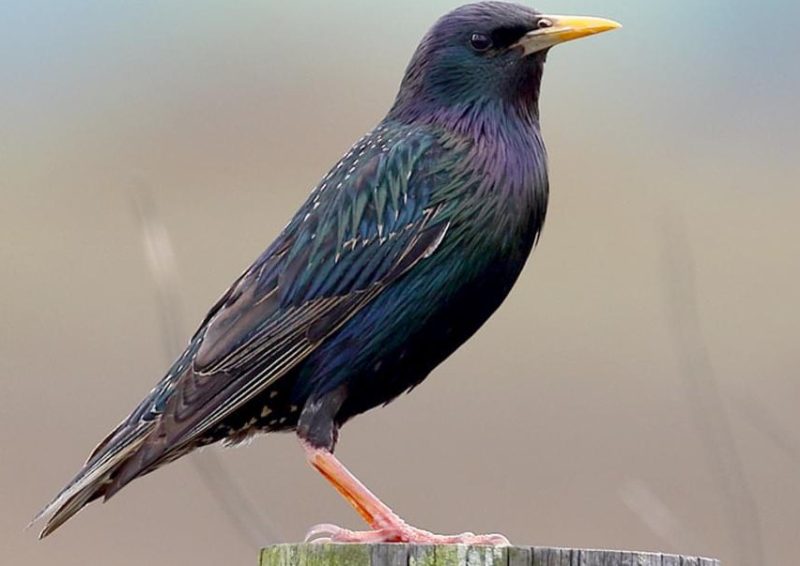
The European Starling is a medium-sized, stocky bird with glossy black plumage that shines with iridescent green and purple hues in the sunlight. During winter, its feathers are spotted with white, creating a speckled appearance. It has a long, slender yellow bill during the breeding season, which turns darker in winter, and bright eyes that stand out against its dark feathers.
Measuring about 7.5–9 inches in length with a wingspan of 12–16 inches, European Starlings are known for their strong, direct flight and noisy, chattering calls. They are highly social birds, often forming large, dense flocks that perform spectacular murmurations in the sky. Their vocalizations include a wide range of whistles, clicks, and mimicry of other species.
In Delaware, European Starlings are abundant and widespread year-round, thriving in urban, suburban, and rural environments. They nest in cavities including buildings, trees, and nest boxes. As an introduced species from Europe, they have become one of the most common birds across the state, often competing with native cavity nesters.
Eastern Bluebird
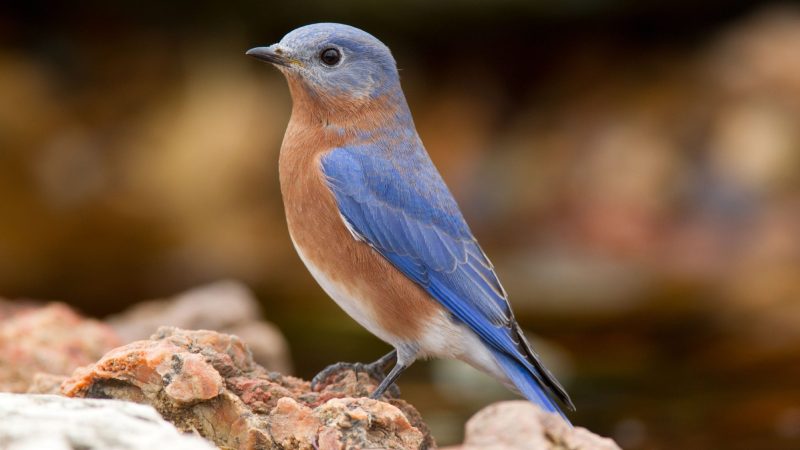
The Eastern Bluebird is a small thrush species easily recognized by its bright blue upperparts and rusty red throat and chest. Males are more vibrantly colored, while females show paler blue and gray tones. Both have a white belly and a slender, pointed bill, giving them a sleek, elegant appearance.
Measuring about 6.5–7 inches in length with a wingspan around 10–12 inches, Eastern Bluebirds have a soft, melodious warble and a series of short whistles. They are often seen perched on fence posts or wires scanning open fields for insects. Their flight is low and buoyant, with steady wing beats.
In Delaware, Eastern Bluebirds favor open habitats like meadows, orchards, and suburban lawns with scattered trees. They nest in cavities and readily use nest boxes provided in parks and backyards. Although their numbers declined in the past due to habitat loss, conservation efforts have helped them rebound in the state.
Chipping Sparrow

The Chipping Sparrow is a small, slender songbird characterized by its bright rufous cap, clear gray face, and black eye line. The rest of its body is mostly brown streaked with gray and white, making it easy to distinguish from other sparrows during the breeding season. In winter, its coloration is duller but still recognizable.
Measuring about 5 inches long with a wingspan of 7.5–9 inches, Chipping Sparrows are known for their rapid, dry trill song often heard in spring and summer. They are active foragers on the ground and in low vegetation, feeding mostly on seeds and insects. Their flight is quick and direct, with short bursts of fluttering.
In Delaware, Chipping Sparrows breed in open woodlands, parks, and suburban areas with scattered trees and shrubs. They migrate south for the winter but can occasionally be seen during colder months. Their distinctive song and cap make them a familiar sight during the warmer seasons.
Gray Catbird
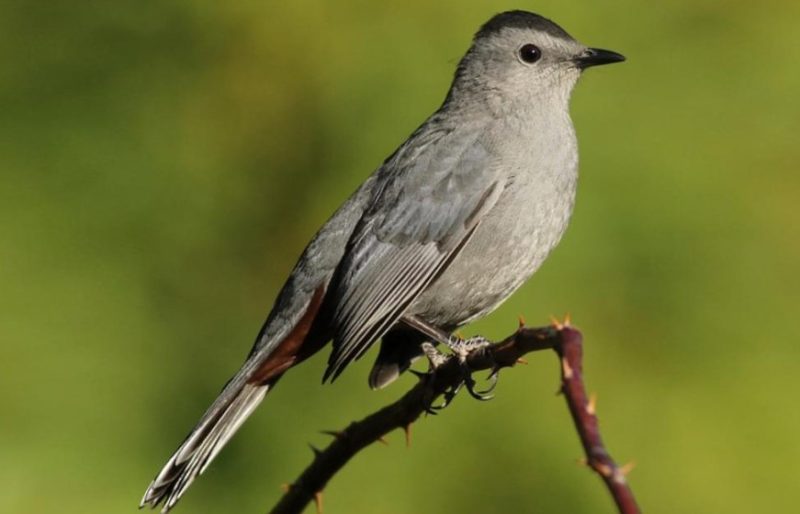
The Gray Catbird is a medium-sized songbird with soft, slate-gray plumage, a black cap, and rusty undertail coverts. Its overall sleek appearance and unique, cat-like “mew” calls give it its name. Unlike many colorful songbirds, its muted colors help it blend into dense shrubs and thickets.
Measuring about 8–9 inches long with a wingspan of 11–13 inches, Gray Catbirds are highly vocal and capable of mimicking other birds and sounds. Their song is a varied mix of whistles, clicks, and meows, often repeated in complex phrases. They are secretive but may be seen hopping near dense vegetation.
In Delaware, Gray Catbirds are common summer residents found in thick shrubs, woodland edges, and gardens. They prefer habitats with dense undergrowth where they forage for insects and berries. After breeding, many migrate south for winter, though a few may overwinter in milder areas.
Yellow-rumped Warbler (Winter)
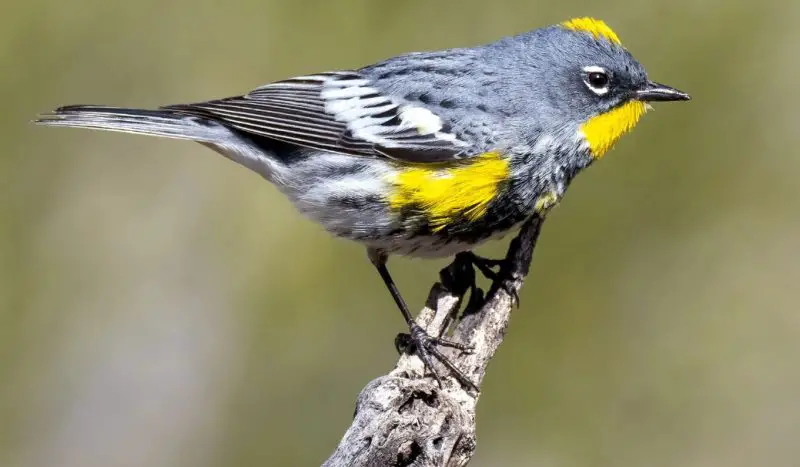
The Yellow-rumped Warbler in winter plumage is a medium-sized warbler with mostly gray and brown feathers accented by bright yellow patches on the rump, sides, and sometimes the crown. The streaked body and white throat contrast with the bold yellow markings, making it one of the easiest warblers to identify outside the breeding season.
Measuring about 5–6 inches long with a wingspan of 8–11 inches, this warbler is an active, restless flier, often seen flicking its wings and tail while foraging. Its call is a sharp “check” sound, and the song consists of a rapid trill. In winter, it feeds on berries as well as insects when available.
In Delaware, Yellow-rumped Warblers are common winter visitors, frequenting woodlands, thickets, and suburban areas. Their ability to digest waxy berries allows them to survive colder months when insect food is scarce. They are often seen in mixed flocks with other small birds during the winter season.
Common Yellowthroat (Summer)

The Common Yellowthroat is a small, brightly colored warbler notable for the male’s striking black mask bordered by white above and below. Males display olive-green upperparts and bright yellow throats and underparts, while females and juveniles are duller and lack the bold mask. Their short, rounded wings and relatively long tails add to their distinctive silhouette.
Measuring about 4.3–5 inches in length with a wingspan of roughly 6.7–7.9 inches, Common Yellowthroats are active and agile, frequently flitting through dense vegetation. Their distinctive call is a loud “wichity-wichity-wichity,” often heard in marshes and thick brush during breeding season. They feed on insects, spiders, and other small invertebrates.
In Delaware, Common Yellowthroats are common summer residents, favoring wetland habitats like marshes, wet meadows, and shrubby edges of ponds. They breed here during spring and summer months, disappearing in fall as they migrate south for the winter. Their secretive nature means they are often heard before seen.
Eastern Towhee
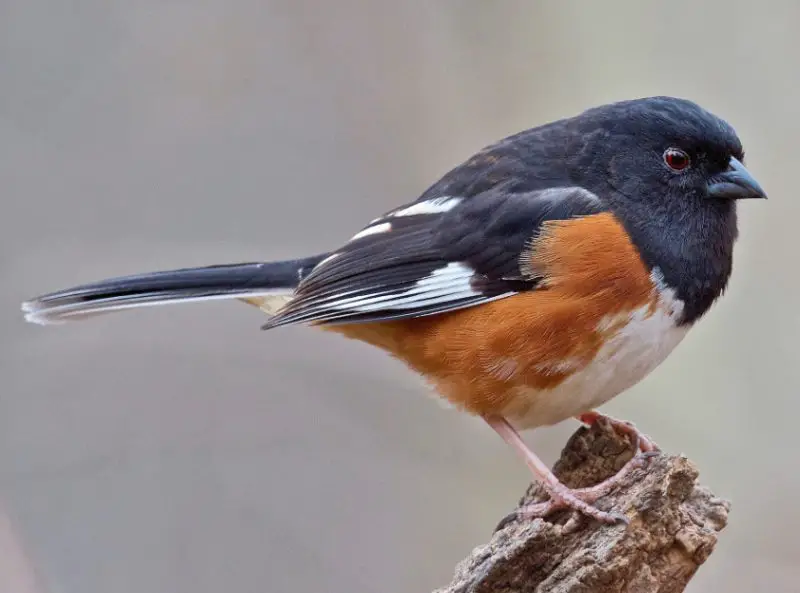
The Eastern Towhee is a striking sparrow with bold black, white, and rufous coloring. Males have glossy black upperparts, white bellies, and bright rusty sides, while females are more brownish in place of black. They have long tails with white edges and a strong, clear “drink-your-tea” song that makes them easy to identify.
Measuring about 7–8.5 inches long with a wingspan of 10–12 inches, Eastern Towhees are ground foragers, often scratching through leaf litter with both feet in a behavior known as “double-scratching.” Their calls include sharp “chewink” notes and rattling trills. They are more often heard than seen, usually hiding in dense underbrush.
In Delaware, Eastern Towhees inhabit woodlands, forest edges, thickets, and brushy fields, especially during breeding season in spring and summer. They remain in the state year-round but are less vocal in winter. Their preference for dense cover provides essential shelter and feeding opportunities.
Dark-eyed Junco (Winter)

The Dark-eyed Junco is a small, sparrow-like bird easily recognized by its slate-gray head and back, white belly, and pinkish bill. Some regional variants show more brown or black coloring, but all have contrasting light underparts. These birds have a distinctive, clean appearance and a fairly long tail often flicked during movement.
Measuring approximately 5–6 inches long with a wingspan of 7.5–9.8 inches, Dark-eyed Juncos are often seen hopping on the ground or near feeders, feeding mainly on seeds and insects. Their song is a musical trill, and their call notes are sharp and clear. They tend to flock in winter and are among the most familiar backyard birds during the colder months.
In Delaware, Dark-eyed Juncos are common winter visitors, arriving in the state as breeding birds from the north migrate south. They prefer open woodlands, forest edges, and suburban backyards where they can find scattered seed and shelter. They typically leave the region in early spring to return north for breeding.
Eastern Phoebe (Spring – Summer)

The Eastern Phoebe is a small flycatcher with plain gray-brown upperparts and pale underparts. Unlike many brightly colored songbirds, it lacks striking markings but is easily identified by its habit of wagging its tail downward repeatedly. Its bill is short and broad, perfect for catching flying insects.
Measuring about 6–7 inches in length with a wingspan of 10–11 inches, Eastern Phoebes have a distinctive, raspy “fee-bee” call. They perch on low branches or fence posts and sally out to catch insects midair. Their flight is direct and somewhat bouncy, and they are one of the earliest migrating birds to return in spring.
In Delaware, Eastern Phoebes arrive in early spring to breed near water bodies, open woodlands, and suburban areas. They build nests under bridges, eaves, and ledges, often near human habitation. They remain in the area through summer before migrating south for the winter months.
House Wren (Spring – Summer)
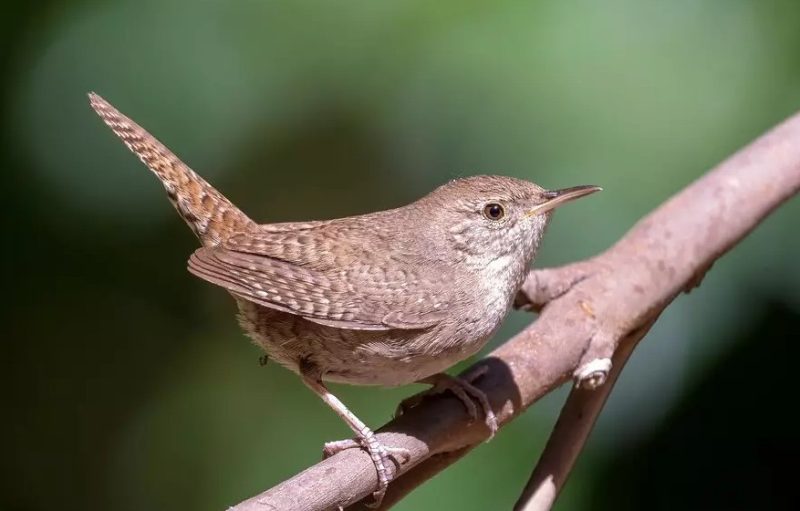
The House Wren is a small, energetic bird with mottled brown plumage and a slightly barred tail. It has a thin, slightly curved bill and bright, expressive eyes. Although dull in color, its bubbly and complex song makes it a lively presence during the breeding season.
Measuring about 4.3–5 inches in length with a wingspan of 6.3–8.3 inches, House Wrens are very active and curious, often found flitting through shrubs, gardens, and wood edges. Their rapid, gurgling song consists of a series of bubbly phrases. They nest in cavities, including nest boxes, holes in trees, or man-made structures.
In Delaware, House Wrens arrive in spring and breed through summer in a wide range of habitats including suburban yards, open woodlands, and brushy areas. They are territorial during breeding and often use multiple nest sites. After breeding, they migrate south for the winter months.
Northern Flicker
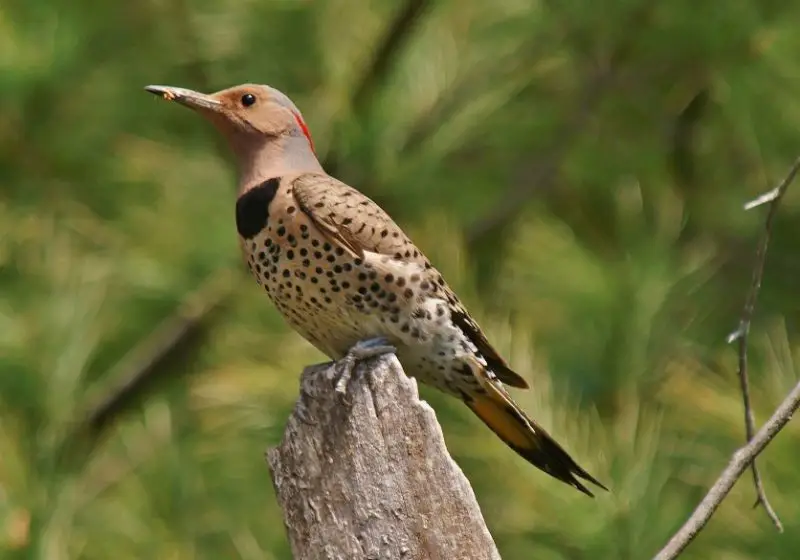
The Northern Flicker is a large woodpecker notable for its brownish body adorned with black spots, barred back, and a distinctive black bib on the chest. One of its most striking features is the bright yellow or red shaft of its flight feathers, visible during flight. It has a slightly curved bill and a white rump patch that flashes when it flies.
Measuring about 11–12 inches in length with a wingspan of 16–20 inches, Northern Flickers are ground foragers, often seen searching for ants and beetles. Their call is a loud, rolling “wicka-wicka” or “flicker” sound, and they drum on trees or metal surfaces during the breeding season. Unlike many woodpeckers, they frequently forage on the ground.
In Delaware, Northern Flickers are common residents found in open woodlands, parks, and suburban areas with scattered trees. They nest in tree cavities and are active throughout the year. Their striking flight pattern and unique calls make them a favorite among birdwatchers.
Tree Swallow (Warm Season)
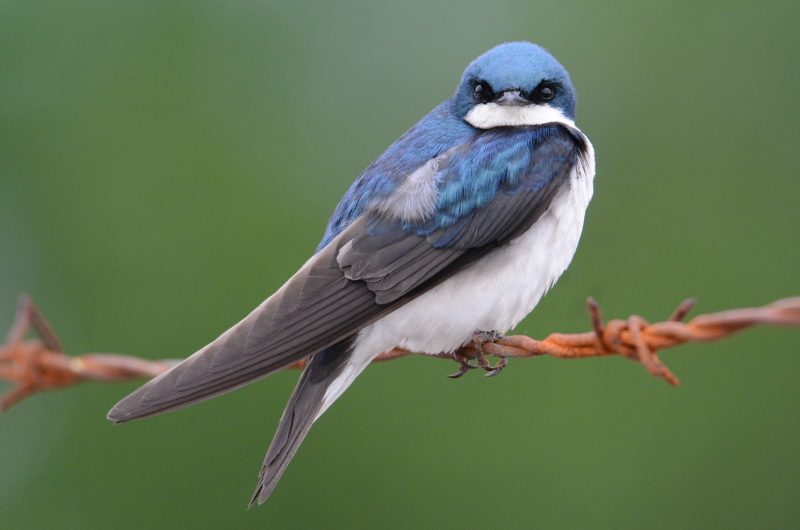
The Tree Swallow is a sleek, graceful bird with iridescent blue-green upperparts and clean white underparts. Its streamlined body and long, pointed wings enable agile flight as it hunts insects in midair. They have a small, slightly curved bill suited for catching flying prey.
Measuring about 5–6 inches long with a wingspan of 11–13 inches, Tree Swallows produce a series of soft, chattering calls and a high-pitched twittering song. They are highly social, often nesting in colonies and readily using nest boxes. Their acrobatic flight and aerial feeding are hallmarks of their behavior.
In Delaware, Tree Swallows are common migrants and summer residents, arriving in spring and staying through warm months to breed near ponds, marshes, and open fields. They prefer open habitats with access to water and abundant flying insects. They migrate south in late fall to warmer climates.
Ruby-throated Hummingbird (Spring – Summer)
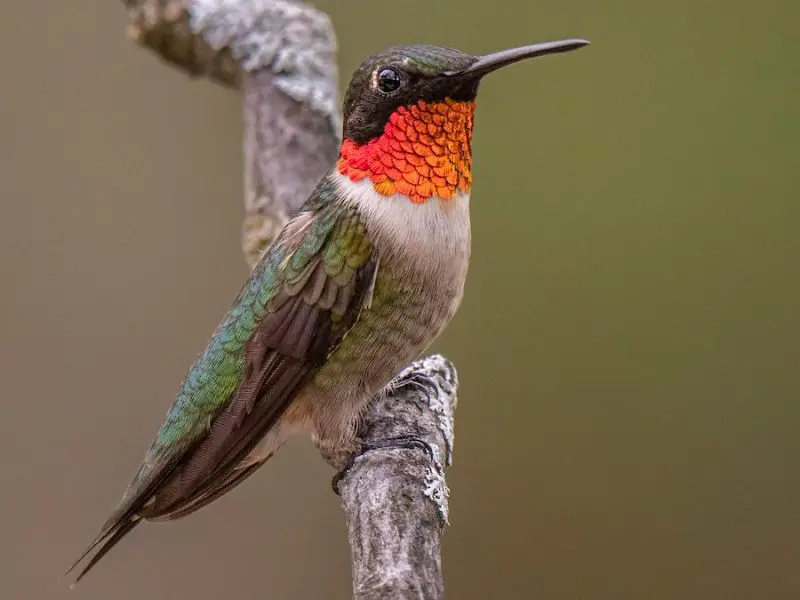
The Ruby-throated Hummingbird is a tiny, jewel-like bird famous for the male’s brilliant red throat patch, or “gorget,” which shines vividly in sunlight. Females lack the red throat but share the metallic green back and white underparts. Both sexes have long, slender bills adapted for feeding on nectar.
Measuring only about 3–3.5 inches long with a wingspan of 4–5 inches, Ruby-throated Hummingbirds are known for their rapid, hovering flight and ability to fly backward. Their high-pitched, buzzing call is faint but distinctive. They feed primarily on flower nectar, supplemented by tiny insects and spiders.
In Delaware, Ruby-throated Hummingbirds arrive in spring and breed through summer, frequenting gardens, woodland edges, and meadows rich in flowering plants. They migrate south in late summer or early fall, often crossing the Gulf of Mexico during migration. Providing feeders helps support them during their stay.
Great Crested Flycatcher (Summer)

The Great Crested Flycatcher is a medium-sized, robust flycatcher with olive-brown upperparts, bright yellow belly, and rufous crest and tail edges. Its large, slightly hooked bill is well suited for catching insects. It is known for its loud, rolling “whee-eep” call that echoes through wooded areas.
Measuring about 7.5–8 inches long with a wingspan of 12–13 inches, Great Crested Flycatchers are skilled aerial hunters, darting out from perches to snatch flying insects. They also consume fruits and berries occasionally. Their habit of nesting in tree cavities or old woodpecker holes is notable.
In Delaware, Great Crested Flycatchers are common summer residents inhabiting deciduous forests, woodlots, and suburban parks. They arrive in late spring to breed and leave by early fall to migrate south. Their distinctive calls and colorful appearance make them a favorite for bird enthusiasts.
Hairy Woodpecker
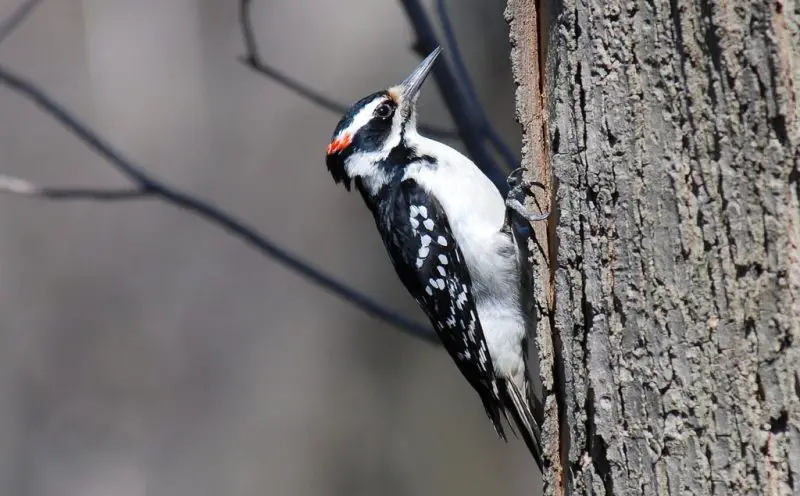
The Hairy Woodpecker is a medium-sized woodpecker similar in appearance to the smaller Downy Woodpecker but larger and with a longer, more robust bill. It has black and white plumage with a white back and black wings with white spots. Males show a small red patch on the back of the head.
Measuring about 9–10 inches long with a wingspan of 14–17 inches, Hairy Woodpeckers drum loudly and frequently on tree trunks to establish territory. Their calls include sharp “peek” notes. They forage mainly by probing tree bark for insects but also eat seeds and berries.
In Delaware, Hairy Woodpeckers are permanent residents found in mature forests, wooded suburbs, and parks. They nest in cavities and are often seen alongside Downy Woodpeckers, though their larger size and longer bill help distinguish them. Their steady drumming and striking appearance make them unmistakable.
Yellow Warbler (Summer)

The Yellow Warbler is a small songbird famous for its bright yellow plumage and cheerful song. Males are entirely yellow with reddish streaks on the chest, while females tend to be paler with fewer streaks. Its round head, sharp pointed bill, and large dark eyes give it a lively appearance.
Measuring about 4.3–5 inches in length with a wingspan of 6.7–7.9 inches, the Yellow Warbler has a sweet, musical series of clear notes often described as “sweet sweet sweet, I’m so sweet.” They are active and quick, frequently flitting through shrubs and small trees as they forage for insects.
In Delaware, Yellow Warblers are common summer breeders found near wetlands, thickets, and riparian woodlands. They prefer areas with dense vegetation for nesting and feeding. After the breeding season, they migrate south to Central and South America for the winter.
Cedar Waxwing (Fall – Spring)

The Cedar Waxwing is a sleek, elegant bird with soft, silky plumage in shades of brown, gray, and yellow. Its black mask bordered by white and bright red waxy tips on the wing feathers give it a distinctive look. The tail ends with a bright yellow band, making it easy to identify.
Measuring about 6–7 inches in length with a wingspan of 8–11 inches, Cedar Waxwings are social and often travel in flocks. Their high-pitched, trilling calls and soft whistles are common sounds in Delaware’s woodlands and suburban areas. They feed mostly on fruits and berries but also consume insects.
In Delaware, Cedar Waxwings are typically present during fall, winter, and spring months, migrating south for the coldest periods. They favor open woodlands, orchards, and berry-producing shrubs where they can forage. Their ability to eat large amounts of fruit helps them survive the colder seasons.
Red-eyed Vireo (Summer)
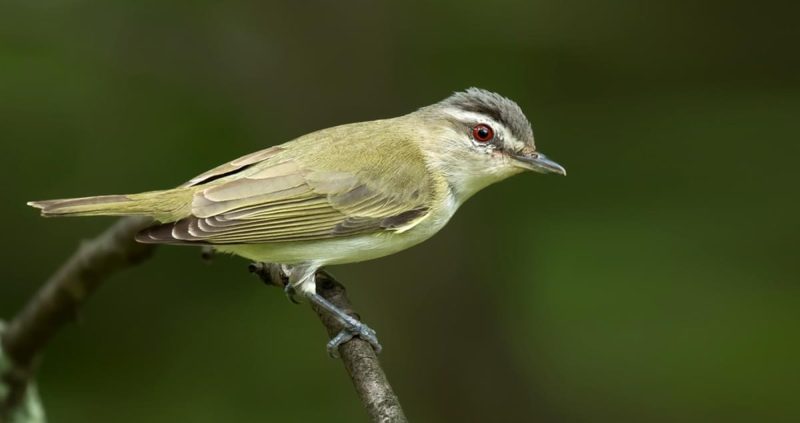
The Red-eyed Vireo is a small songbird known for its olive-green upperparts, white underparts, and striking red eyes. It has a bold black line through the eyes and a white eyebrow stripe above. This bird’s subtle coloration makes it blend well into leafy tree canopies.
Measuring about 5–6 inches in length with a wingspan of 8.7–10.6 inches, the Red-eyed Vireo is a prolific singer, known for its repetitive, clear phrases delivered throughout the day. Its song is one of the most commonly heard in deciduous forests during the summer months.
In Delaware, Red-eyed Vireos breed in mature forests and wooded suburbs, favoring tall trees with dense foliage. They arrive in late spring and depart in early fall to spend winters in Central and South America. Their persistent singing and quiet presence make them a signature summer bird in the region.
Northern Parula (Spring and Summer)

The Northern Parula is a small warbler notable for its bluish-gray upperparts, yellow throat and chest, and distinctive white eye arcs. Males have a chestnut band across the breast, while females and immature birds are less brightly colored. Their tiny size and quick movements help them flit among tree branches and mossy limbs.
Measuring about 4–4.5 inches long with a wingspan of 6.7–7.9 inches, Northern Parulas produce a high-pitched, buzzy trill often heard in early summer. They feed primarily on insects and spiders, gleaning from leaves and bark in mature forests and wooded swamps.
In Delaware, Northern Parulas arrive in spring to breed in moist woodlands, especially near water. They nest in hanging moss or old nests built by other birds. After breeding, they migrate south to the tropics, making their stay in Delaware relatively brief but noticeable.
Baltimore Oriole (Summer)

The Baltimore Oriole is a vibrant songbird with brilliant orange and black plumage in males, while females display duller yellow-orange colors with grayish wings. Its long, slender bill and pointed wings contribute to its elegant appearance. This bird is known for its rich, flutelike song and hanging basket-shaped nests.
Measuring about 7–8 inches in length with a wingspan of 9–12 inches, Baltimore Orioles produce clear, melodious whistles and are active foragers in the tree canopy. They primarily feed on insects, fruit, and nectar, often visiting hummingbird feeders.
In Delaware, Baltimore Orioles are summer visitors, arriving in late spring to breed in open woodlands, parks, and suburban areas. They construct elaborate hanging nests in deciduous trees. After the breeding season, they migrate south to Central America and northern South America for the winter.
Blue-gray Gnatcatcher (Spring – Summer)
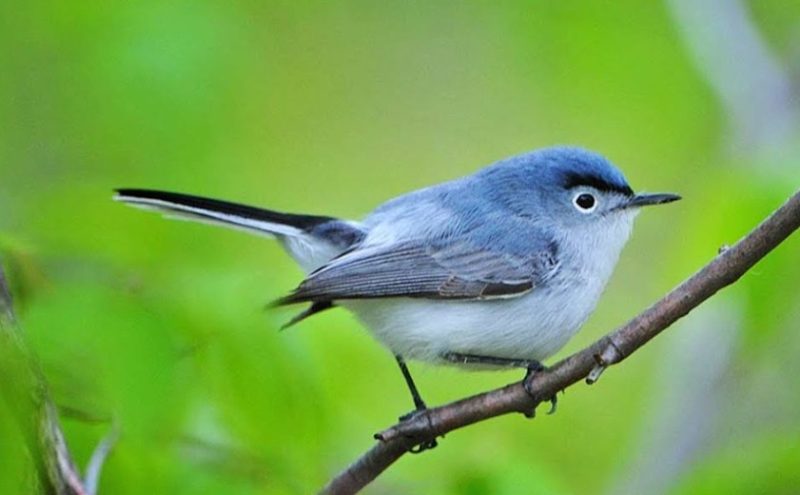
The Blue-gray Gnatcatcher is a small, slender songbird characterized by its soft blue-gray upperparts, white underparts, and a long, thin tail edged with white. It has a small, thin bill perfect for catching tiny insects midair. Males often display a small black cap during the breeding season.
Measuring about 4.3–5 inches in length with a wingspan of 6.7–7.9 inches, Blue-gray Gnatcatchers are very active and agile, frequently flicking their tails upward. Their call is a soft, high-pitched “zkreee” and their song consists of a rapid series of buzzy notes. They glean insects from foliage in trees and shrubs.
In Delaware, Blue-gray Gnatcatchers arrive in spring to breed and are commonly found in deciduous forests, woodland edges, and suburban areas with dense shrubbery. They remain through the summer before migrating south in the fall. Their tiny size and energetic behavior make them a delight to spot.
Ruby-crowned Kinglet (Spring – Fall)
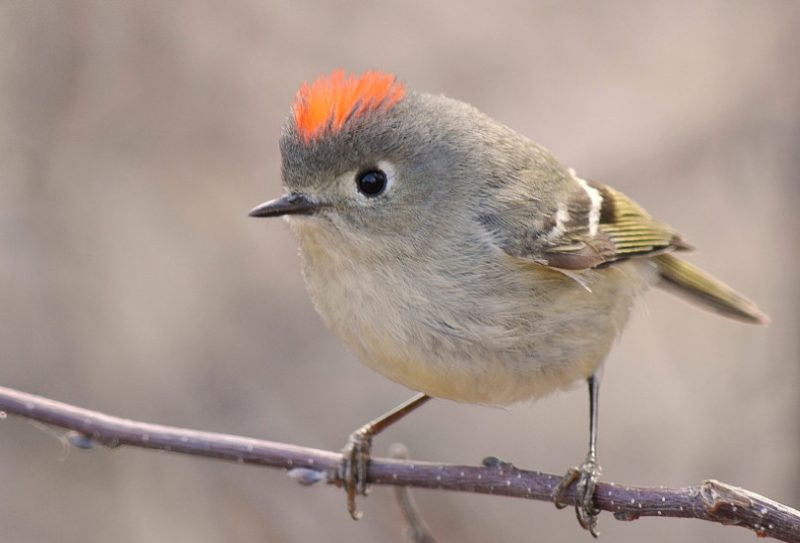
The Ruby-crowned Kinglet is a small, round songbird with olive-green upperparts and grayish underparts. Its most distinctive feature is the bright red crown patch on males, usually concealed except during displays. Both sexes have a white eye ring and two white wing bars.
Measuring about 4–4.5 inches long with a wingspan of 6.7–7.9 inches, Ruby-crowned Kinglets are active and restless, constantly flicking their wings and moving through foliage. Their call is a thin, high-pitched “see see see,” and their song is a complex series of whistles and trills.
In Delaware, Ruby-crowned Kinglets are present from spring through fall, favoring mixed and coniferous forests, woodland edges, and brushy areas. They migrate south in late fall but may be seen during migration periods. Their small size and lively movements make them a fascinating species to observe.
White-throated Sparrow (Winter)
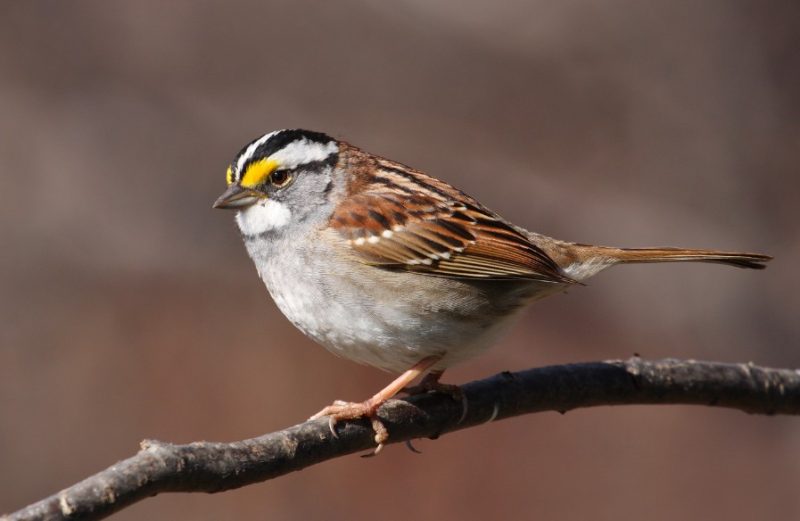
The White-throated Sparrow is a medium-sized songbird notable for its striking white throat patch, yellow spots between the eyes and bill, and bold black-and-white striped crown. Its brown and gray streaked body provides excellent camouflage on the forest floor.
Measuring about 6–7 inches in length with a wingspan of 8.7–10.6 inches, White-throated Sparrows have a distinctive, clear whistled song often described as “Oh-sweet-Canada-Canada.” They forage on the ground, feeding on seeds, insects, and berries.
In Delaware, White-throated Sparrows are common winter visitors, frequenting forests, brushy fields, and suburban backyards. They arrive in the fall and stay through winter, departing in spring for northern breeding grounds. Their melodic song is a welcome sound in quieter winter landscapes.
Pine Warbler (Pine Forests, Possibly Year-round)
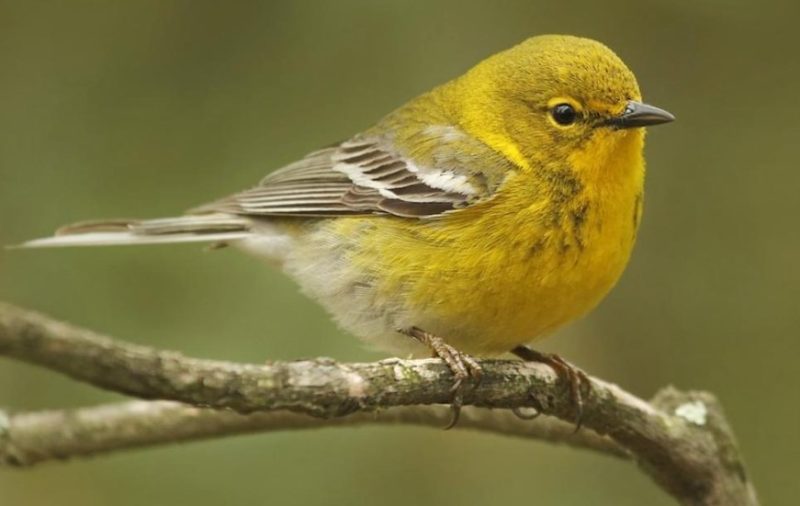
The Pine Warbler is a medium-sized warbler with olive-green upperparts and yellow underparts. Males are brighter with more vivid yellow coloring, while females and juveniles are duller. It has a relatively long tail and a pointed bill adapted for foraging in pine trees.
Measuring about 5–5.5 inches long with a wingspan of 7.5–9 inches, Pine Warblers have a slow, musical trill song often heard in pine forests. They feed primarily on insects, seeds, and pine sap, frequently seen creeping along branches and trunks.
In Delaware, Pine Warblers inhabit pine woodlands and plantations and may be present year-round. They nest in tree cavities or build cup nests in pines. Their strong association with pine forests makes them a specialized species within the state’s mixed habitats.
Field Sparrow (Grasslands, Shrubby Areas)
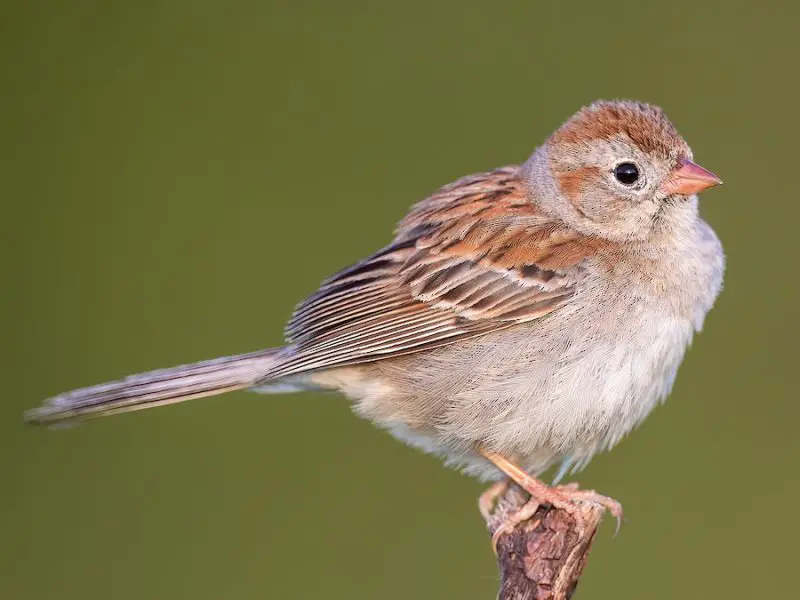
The Field Sparrow is a small, delicate sparrow with a warm pinkish bill, plain gray face, and subtle rufous crown. It has light brown upperparts with fine streaking on the back and a clean, unstreaked pale belly. Its soft, clear whistle is distinctive in open habitats.
Measuring about 5.5–6 inches in length with a wingspan of 7.5–9 inches, Field Sparrows are known for their repeated, bell-like song that sounds like a distant, clear “see-oh.” They forage mostly on the ground for seeds and insects and are shy and unobtrusive.
In Delaware, Field Sparrows prefer open fields, grasslands, and shrubby edges where they breed during spring and summer. They are less common in heavily wooded areas and are often found in early successional habitats. Their gentle song and unobtrusive nature make them a quiet presence in rural landscapes.
Swamp Sparrow (Wetlands, Fall – Spring)
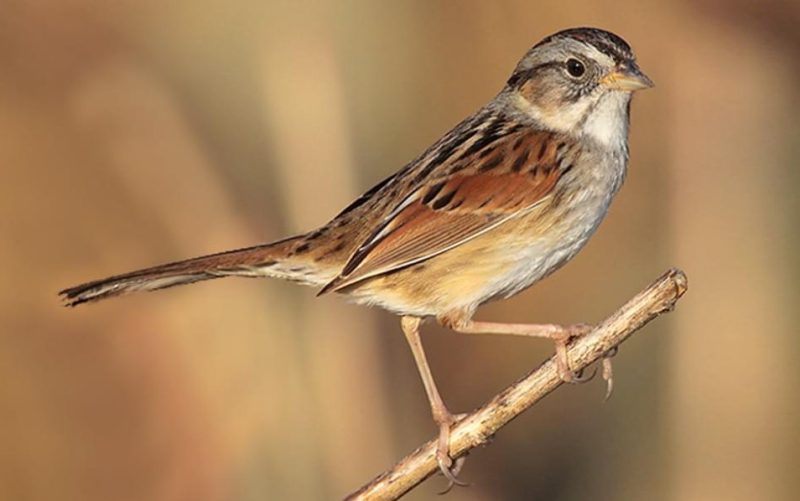
The Swamp Sparrow is a medium-sized sparrow with warm brown upperparts, a rusty cap, and a grayish face and underparts. Its wings have faint streaks, and it sports a short, thick bill adapted for foraging in marshy environments. Its plumage blends well with the dense reeds and grasses of wetlands.
Measuring about 5.5 inches in length with a wingspan of 7.5–9 inches, Swamp Sparrows have a soft, buzzy trill and a distinctive “tsew” call. They forage on the ground and among vegetation for insects and seeds, often in dense marsh habitats where their secretive behavior helps them avoid predators.
In Delaware, Swamp Sparrows are common fall and winter visitors frequenting marshes, swamps, and wet meadows. They arrive in the state in the fall and stay through early spring before migrating north to breed. Their presence in wetlands makes them an important indicator species for healthy marsh ecosystems.
Savannah Sparrow (Coastal Grasslands)

The Savannah Sparrow is a small sparrow characterized by its streaked brown and white plumage and a small, distinct yellow patch above the eye. Its short tail and sharp bill complement its slender build. This species is often seen hopping on the ground in open grasslands.
Measuring about 5–6 inches long with a wingspan of 7.5–9.5 inches, Savannah Sparrows produce a buzzy, insect-like song and a sharp “tsip” call. They forage mainly on seeds and insects, often seen in flocks during migration and winter months.
In Delaware, Savannah Sparrows inhabit coastal grasslands, salt marsh edges, and open fields. They breed in northern areas but are commonly observed during migration along Delaware’s shores and fields in spring and fall. Their preference for open habitats near the coast makes them a distinctive species in the region.
Winter Wren (Winter, Moist Forests)

The Winter Wren is a tiny, round bird with rich brown plumage, fine barring on the wings and tail, and a short, stubby tail often held upright. Its small size belies its loud, complex song, which consists of bubbly, musical phrases repeated rapidly.
Measuring about 4–5 inches long with a wingspan of 6.5–8 inches, Winter Wrens are agile foragers that creep along mossy logs and tree trunks in damp, mature forests. Their calls include sharp “tick” sounds and melodious songs heard mostly in winter and early spring.
In Delaware, Winter Wrens are uncommon winter residents found primarily in moist, shaded forests and wooded ravines. They remain during colder months, often sheltering in dense understory and brush piles. Their elusive behavior and powerful song make them a special sight in the state’s winter woods.
Brown-headed Nuthatch (Southern Delaware, Pine Forests)
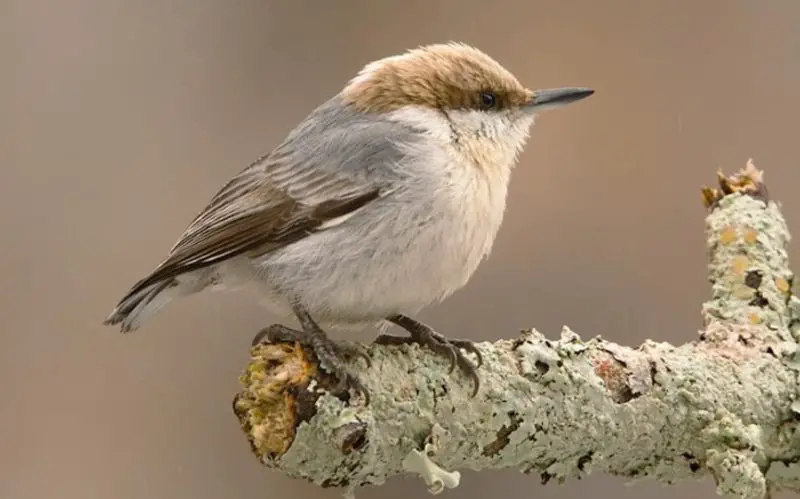
The Brown-headed Nuthatch is a small, stout bird with pale gray upperparts, a distinctive warm brown cap, and white underparts. It has a short tail and a strong, slightly curved bill used for probing bark. Its behavior includes climbing and hanging on pine trunks and branches.
Measuring about 4.5 inches long with a wingspan of 6.5–7.5 inches, Brown-headed Nuthatches have a nasal, yipping call and are known for their curious and social nature. They often work in small family groups and cache seeds in bark crevices for winter.
In Delaware, Brown-headed Nuthatches are rare and localized in the southern pine forests of the state. They prefer mature pine woodlands and pine plantations, relying on these habitats for foraging and nesting. Their limited range makes them a special species for birdwatchers in Delaware.
Black-capped Chickadee (Very Rare, Northern Border Only)

The Black-capped Chickadee is a small, charismatic bird with a black cap and bib, white cheeks, and soft gray body. It is similar to the Carolina Chickadee but distinguished by vocalizations and slight range differences. This species is more common further north but rarely occurs in Delaware.
Measuring about 5 inches long with a wingspan of 6–8 inches, Black-capped Chickadees have a distinctive “chick-a-dee-dee-dee” call and a clear whistled song. They are curious, acrobatic birds that forage for insects and seeds in mixed forests and woodlands.
In Delaware, Black-capped Chickadees are very rare and typically only found near the northern edge of the state, close to the Pennsylvania border. Their limited presence makes sightings noteworthy for local birdwatchers. They prefer cooler, mixed hardwood and coniferous forests.


